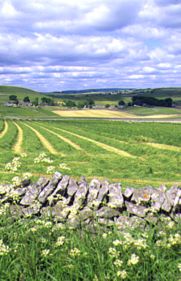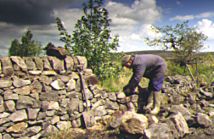The Peak District and Banff National Parks
Banff National Park
BNP problems;

- Competition for land in the valley floor (Montane Ecoregion), which is the most biologically rich area and yet over a third of it has already being subjected to development.
- Grizzly bears, wolves, cougars, lynx, wolverines, otter and moose have all been ‘displaced or eliminated’ from the Bow River Valley
BNP solution
- Wildlife corridors have been proposed and some created, so that wildlife can circumnavigate human developments, especially crucial for those that are wide ranging, such as bears and wolves.
- The Fairholme Range-Carrot Creek Benchland, an area of Montane habitat has been set aside as an environmentally sensitive site, and human use much reduced.
- A wildlife crossing has been built across the Two Jack Canal.
- Underpasses have been built under the TCH, along with fences to direct bears to the tunnels, but they have not been accepted, so while road deaths may be reduced, so is the motility of the bears.
- Latterly, two 50m overpasses have been built, but their effectiveness is yet to be ascertained.
- Liaisons with water companies, such as TransAlta Utilities, regarding restoration of more natural water flow in to the Cascade and Spray systems is also pertinent.
Peak District National Park
PDNP Problems;

- 50% of the PDNP’s flower rich meadows were lost (1985-95)
- General decline in floristic diversity of the park by 26%.
- 45% decline in water vole population between 1969 and 1999.
- The loss of field boundaries, especially dry stone walls, (approximately 258km in the 1970's and 1980's).
- Loss of lead rakes is of cultural and habitat significance
PDNP solutions

- Promotion of good management and recreation strategies
- Promotion of alternative farming practices and associated support
- Implementation of the Local Biodiversity Action
Top of Page
Banff National Park

The BNP Authority is unlikely to achieve it’s objectives in a less officious way, and although there have been conflicts over land use, a balance seems to have been achieved. For example, horse outfitters are permitted to operate in specified locations, indicating leniency, compared to the U.S.
Such reforms have not been welcomed by all sectors of the community though. Not surprisingly the ski operators have objected and fought legal battles over what they proclaim their right to develop ‘their’ ski areas as they see fit, or at least maintain the right to upgrade for safety reasons. Parks Canada is yet to stand down, despite the potential economic ramifications of a declining ski industry.
Peak District National Park

New buildings, roads or other developments in the PDNP must be conclusively proved to be necessary for the park before they approved. Changes to buildings must be made so that they correspond to the architecture of the park. The PDNPA is also addressing the lack of "affordable" housing for local residents. The park is being continually opened up for the public to explore and enjoy and the regulations in place are minimal when compared with the restrictions upon human movement in wilderness areas.
Top of Page
Other Pages
Home
Study Aims and Park Background
Management Principles 1 & 2
Management Principles 3 & 4
Management Principles 5 & 6
Management Principles 7 & 8
Management Principles 11 & 12
Management Principle 13
Conclusion
Home





